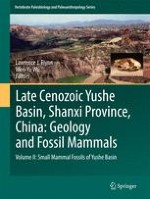2017 | OriginalPaper | Buchkapitel
14. The Murine Rodents of Yushe Basin
verfasst von : Wen-Yu Wu, Lawrence J. Flynn, Zhu-Ding Qiu
Erschienen in: Late Cenozoic Yushe Basin, Shanxi Province, China: Geology and Fossil Mammals
Verlag: Springer Netherlands
Aktivieren Sie unsere intelligente Suche, um passende Fachinhalte oder Patente zu finden.
Wählen Sie Textabschnitte aus um mit Künstlicher Intelligenz passenden Patente zu finden. powered by
Markieren Sie Textabschnitte, um KI-gestützt weitere passende Inhalte zu finden. powered by
